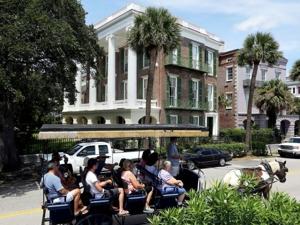Anyone who lives in Charleston should know that the architecture is a must-see visual spectacle and has its own place in the City's history. It’s an art form, and each style is a physical marker notating every century the Holy City has seen since it was first established. "Charleston was founded in 1670, so a long range of architectural styles have been present," said Phillip D.
Smith, assistant professor of classical architecture and design at the American College of the Building Arts. "As fast as architectural styles were popularized in Europe, there would be a two- to three-month delay before they got to the colonies." Smith explains that in Charleston, there are a handful of colonial buildings.

"An example of a colonial home is one of the oldest homes in Charleston – the Pink House, located at 17 Chalmers Street," said Smith. "It's a colonial building that's very much in line with what you would have seen perhaps in London." The Pink House, made of pinkish Bermuda stone, was built between 1694 and 1712.
After the Colonial era, Charleston architecture entered the iconic Georgian period. When well-to-do families visited Europe, Smith says they returned to the States with books on art, new experiences and knowledge they incorporated into design. "They leaned into Georgian architecture," said Smith.
“Examples of buildings that took on these characteristics include the Miles Brewton House and Drayton Hall. Georgian Palladian architecture remained a prominent feature in Charleston for a while." Georgian architecture isn't just dictated by its mammoth size.
"It becomes dictated by the material, but also by the symmetry, so you started seeing very symmetrical facades," said Smith. "A smaller example of a Georgian home is the Hayward Washington House, built in 1772." The Heyward Washington House was the townhome of Thomas Heyward, Jr.
, one of four South Carolina signers of the Declaration of Independence. "It has exposed brick, not a lot of stucco," he explained. "There is also a center doorway and two sets of windows on each side.
The defining feature of this architecture, which is not necessarily a hard and fast rule, is smaller square windowpanes." Smith calls the Greek Revival style a huge explosion in Charleston residential architecture. "Phenomenal examples of Greek Revival buildings are the Kahal Kadosh Beth Elohim synagogue, which was built in 1840, and the Roper House, built in 1838," he said.
Finally, a popular style of Charleston residential architecture is Victorian. "The Victorian architecture came here later than the rest of the country, and you could even order mass-produced parts and put the house together," said Smith. "There were people still handcrafting and building things, but they were also working with the economy, so this became easier.
" According to Smith, Charleston today has modern homes purposely built to resemble traditional architecture. They look like they've been around for years.” Thanks to building codes, preservation efforts and zoning laws, Charleston has grown and developed without disrupting the flow of architecture throughout the city.
Any changes to historical buildings must be reviewed, and additions or restorations are designed to fit seamlessly within the fabric of existing architecture. These carefully constructed processes are why walking down any given street in Charleston or touring one of the carefully preserved historic homes truly feels like stepping back in time..
Technology

A Peek at Charleston's Architecture

Anyone who lives in Charleston should know that the architecture is a must-see visual spectacle and has its own place in the City's history. It’s an art form, and each style is a physical marker notating every century the Holy...















